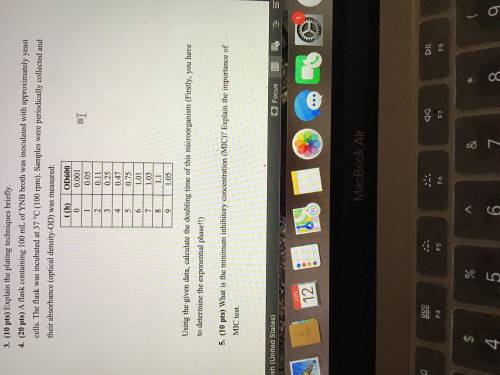
Biology, 13.06.2020 19:57 bigmess559
A flask containing 100ml of YNB broth was inoculated with approximately yeast cells. The flask was incubated at 37 degrees Celsius (100rpm). Samples were periodically collected and their absorbance (optical density-OD) was measured: Using the given data (shown in photo) calculate the doubling time of this microorganism (FIRSTLY, you have to determine the exponential phase!)


Answers: 2


Other questions on the subject: Biology

Biology, 21.06.2019 15:00, SeleneBlackburn25
Which phrases describe an extrusive rock? check all that apply. fine texture cooled slowly small crystal size found deep underground different, easily observed minerals
Answers: 2

Biology, 22.06.2019 02:20, JAYDENJONES0111
What is the function of the somatic nervous system? connects the brain and the spinal cord to the rest of the body carry signals to the muscles and glands includes all nerves controlling the muscular system and external sensory receptors controls internal organs like the heart and bladder
Answers: 2

Biology, 22.06.2019 03:30, amp1955
Students in biology are studying the macromolecules of life. they used a calorimeter to determine the calories in various types of food. once the lab was completed, the students ate the left over food samples. monica commented that in just 6 or 7 "chews" of the saltine, it was gone; nothing but a sticky paste in her mouth. elaborate on what happened chemically while chewing the saltine. include the macromolecules present.
Answers: 1

Biology, 22.06.2019 14:30, ethanseiter
The lineage of pea plants produced round seeds for four generations. the plants that fertilized these pea plants also produced round seeds. however, in the fifth generation, the plant produced to two plants with wrinkled seeds. can that be possible?
Answers: 2
You know the right answer?
A flask containing 100ml of YNB broth was inoculated with approximately yeast cells. The flask was i...
Questions in other subjects:


Chemistry, 18.12.2019 03:31


Social Studies, 18.12.2019 03:31




Physics, 18.12.2019 03:31


Spanish, 18.12.2019 03:31



